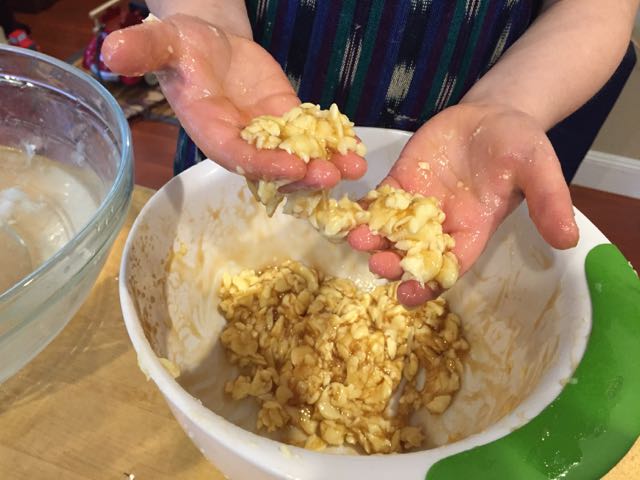Homemade Cultured Maple Butter - Part 2
"Mom. Does everyone in this family have a Christmas list? Or just me? You really should ask for a chef's hat that way we can be chefs together."
On Saturday, we began testing Dave Arnold's ideas about improving our maple butter. As he explained on the podcast, the problem with getting maple syrup into butter is one of water. To get the maple syrup into the butter, you have to either replace as much of the water as possible in the cream with maple syrup, or make the maple syrup more of a solid and knead it into the butter. We tried both approaches.
We started with two pints of heavy cream, kefir grains, maple syrup and salt.
For the first jar, I cooked two cups of cream on low heat, stirring continuously, until the cream had been reduced to 1 1/2 cups. I stopped there because the cream was starting to look a little grainy and weird, like something irreversible was about to happen. I also reduced 1/2 cup of maple syrup to about 1/4 cup. I stopped cooking it when the temperature reached about 245 degrees. Once again, I stopped because the color appeared to be starting to darken and the smell was starting to change, and it seemed that at any second, there would be no turning back. I let the syrup cool down, and I mixed it into the cream. I then cooled the cream mixture, stirring continuously until the mixture was about 90 degrees. At 90 degrees, I found myself so bored with stirring that I just refrigerated the bowl until the mixture was about room temperature. I added a tablespoon of kefir grains and left the cream to ferment overnight. In retrospect, I probably should have just added a tablespoon or two of active kefir so we wouldn't have had to strain the grains out of the thickened cream the next day. I recall considering this option and then going with the grains themselves for a reason I don't remember. I did not hold back later, though, when tweeting my questions about the health of my mapled kefir grains to Amanda Feifer of Phickle. She confirmed that prepared kefir would have been a better way to go, but assured me all would be well with the grains. She's the best.
For the second jar, Wyatt poured the pint of cream into the jar, we added a tablespoon of kefir grains, and we left it to ferment overnight.
On Sunday, we made the crème fraîche in the two jars into butter.




For the first jar, we strained the crème fraîche, whipped it into butter, drained it, rinsed it in cold water, and kneaded in salt. Let me just tell you that the maple-flavored buttermilk that resulted was incredible. Really amazing.
For the second jar, we made the butter the same way. We also made Dave Arnold's recommended "snotty xanthan gel" of maple syrup. I made a 1% fluid gel by first dispersing the xanthan into water because, from what I had read, maple syrup is about 66% sugar and xanthan doesn't hydrate well in liquid that is more than 60% sugar.




As Wyatt said about this preparation, "Try it, Mom! It tastes WAAY better than it looks." The gross-out goo level on butter bits was pretty high, so I actually rinsed the butter bits in cool water in the sieve. Only then was I able to get it all merged back into one ball of butter.
Marc was our taste tester. He concluded, "These both taste really good. But maple? I don't know if they taste like maple. They may be circling maple. They taste sweet to me."
I think the xanthan preparation resulted in stronger maple flavor, but it was still pretty mild. The cream and syrup reduction preparation was even lighter on the maple flavor. After all, much of the maple flavor ended up in the best buttermilk ever created. While the flavor was more robust in the xanthan preparation, the butter unfortunately ended up with little blobs of maple gum throughout. The butter spreads well, but my kneading of that mess was apparently not thorough enough.
There is one more idea that we may eventually try: adding maple sugar to the cream before culturing. Maybe that would work. But before we go there, we will need help eating our way out of the current round of butters.


